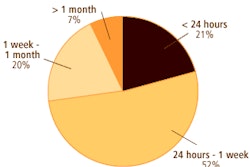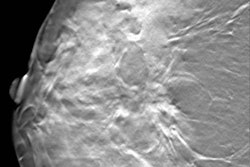Compression during a mammography examination is perceived differently by different women. Some aren't bothered by it at all, whereas others perceive it as an excruciating experience.
Many of these differences may relate to the sensitivity of an individual woman's breasts. But other factors, such as anxiety and embarrassment, may heighten the perception of pain in some cases.
Shirley Long of Mammography Consulting Service in Alberta, British Columbia, recommends taking the following simple steps to help patients through the exam and reduce discomfort among highly sensitive women.
Diminish anxiety
The patient's experience starts the moment she walks into the facility -- not the examining room -- so your facility should offer a relaxing environment to patients. Comfortable decor and soft music can go a long way to help ease tension. Conversely, a stark, noisy office will do the opposite.
During a breast exam, a woman's experience may be colored by preconceptions. If a woman had a bad experience during a past mammogram or heard stories of a friend who had one, she may anticipate the worst, which only compounds the problem, Long said. If you help reduce a woman's anxiety level, you'll also ease her perception of pain, thus preventing her from tensing up, which can make the examination considerably more uncomfortable, she said.
If you sense anxiety in a patient, help her through the process. Find out what she's anxious about, such as the exam itself, the results, and so on, and talk her through it.
Reduce the embarrassment factor
Anxiety and discomfort might also stem from embarrassment during the examination itself. Surprisingly, only a small minority of women are comfortable with their breasts. Most believe they're too big or too small, or have other issues with their appearance, such as inverted nipples or symmetric size.
It can help women feel less self-conscious if you remove only half of the gown during each portion of the examination so they do not feel completely exposed.
"A patient comes in (the room), and you're taking her clothes off and touching her in a very personal way," Long said. "She may feel as if she has totally lost control, and that's a very scary feeling."
Use visual aids
Another way to reduce anxiety is to place visual aids about the value of compression around your office. Long has described a poster that displays a bag of white marbles with a black marble in the middle. It asks the question: "Can you see the black marble?"
In the next frame, it shows the same bag of marbles spread out -- as breast tissue would be during compression -- and the black marble can be seen clearly. This shows the patient why compression helps to detect cancer. Understanding the process can put them more at ease and help them relax for the exam.
Communicate with the patient
Frayed nerves can usually be soothed by open communication. Technologists should always take some time to talk to the patient prior to the examination. Tell her what the examination will involve. Also ask her how her last exam was and whether she experienced any discomfort, including pain from compression or a chill from the plates. Invite comments from the patient during the examination. This will help her feel more in control of the exam and reduce her anxiety level.
"I always start off by telling the patient that I need a certain amount of compression to see the tissue well," Long said.
She also asks the patient to tell her how she feels to give the patient some control over the compression. If the process becomes too uncomfortable, release the breast, adjust it, and then try again.
Long noted that a study on self-compression demonstrated that women who were allowed to compress their own breast using a foot pedal during the examination actually compressed their breast more than the technologist who positioned the other side. This shows how much of a factor control plays in the examination. When the patient is in control, she feels better and might tolerate more compression than technologists typically apply (Radiology, January 1993, Vol. 186:1, pp. 99-102).
Although Long doesn't advise letting patients perform their own compression, she recommends that technologists recognize that when women feel in control of the examination, it can go more smoothly.
Use manual compression instead of the foot pedal
Technologists typically can compress the breast with either a foot pedal or manual control adjustment. Using the manual adjustment after the breast is secured into position can be more gentle and tolerable for the patient than motorized compression.
Technologists should use this technique when possible to help reduce pain for patients.
Use scheduling to your advantage
Breast sensitivity varies from woman to woman and is sometimes hormone-dependent. Women who are still menstruating will often experience increased breast tenderness before their period. If a woman can schedule her periods around her menstrual cycles, the exam will be less painful for her.
Don't be afraid to reschedule
If a patient is having a difficult time during an examination, it might be best to reschedule. If her discomfort is related to her menstrual cycle, have her call back once her period begins and schedule her for 10 days later. Obviously, this is only appropriate for women who come in for an annual screening exam and not for a diagnostic workup patient.
In some cases, you might want to advise the woman to talk to her physician about taking an analgesic prior to her appointment to help dull the pain from the exam.
By Kelly Bilodeau
AuntMinnie.com contributing writer
June 27, 2006
The "Mammography Regulation and Reimbursement Report" is a 12-page monthly newsletter designed specifically for mammographic technologists and supervisors that is published by HC Pro. The periodical offers ideas for better practice management from peers, billing tips, MQSA regulatory updates and guidance, and business ideas related to breast imaging. For a free trial subscription, please click here.
Related Reading
Digital mammography: Can your facility afford to make the leap? May 11, 2006
MQSA reauthorization: What to expect and how to prepare, April 13, 2006
Increasing patient satisfaction seen in reduced wait times, March 28, 2006
Sidestepping screening: What factors make women avoid annual mammography? October 10, 2005
When push comes to shove: Addressing compression in mammography, October 5, 2004
Copyright © 2006 HC Pro



















